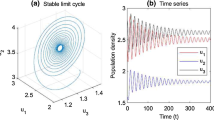Abstract
In this paper, we derive and analyze both analytically and numerically a mathematical model for three interacting populations. These take the form of a herbivore, a plant, and a pollinator. The full model is a nonlinear reaction–diffusion–advection system, which is derived on the basis of a series of plausible and widely supported ecological hypothesis. The study we present here deals with the conditions for the coexistence of the three interacting species. The analysis is carried out in two stages. For the homogeneous case, the mathematical model reduces to a nonlinear three-dimensional autonomous ODE system, which, as the ecological parameters change, exhibits different dynamical behaviors, namely a limit cycle and a positive attractor. The non-homogeneous case is studied mainly by means of numerical simulations of the full model defined on a rectangular region and considering appropriate initial and boundary conditions. Our results strongly suggest the stabilizing role played by the herbivore population which, in turn means that the introduction of this population into the mutualistic pollinator–plant interaction, favors the coexistence of the three interacting species.








Similar content being viewed by others
Notes
The concepts Holling functional and numerical responses of the different types comes from a predator–prey interaction. Here, we are borrowing it such a concept. In our context, the first one captures the fact the pollinators have a limited capacity for visiting plants. The rate of pollinators visits (per pollinator) to plants, is a monotonic increasing function whose graph is asymptotic to a horizontal straight line.
References
Barnes, B., Sidhu, H.: Plant-herbivore models, where more grass means fewer grazers. Bull. Math. Biol. 67, 33–55 (2005)
Boucher, D.H.: The Biology of Mutualism. Oxford University Press, Oxford (1982)
Del Muro González, G.: Dinámica de algunos modelos mutualistas. Tesis de licenciatura en Matemáticas, Facultad de Ciencias, UNAM (2004) (in Spanish)
Edelstein-Keshet, L.: Mathematical models in Biology. The Random House/Birkhauser, Mathematics Series (1998)
Hofbauer, J., Sigmund, K.: Evolutionary Games and Population Dynamics. Cambridge University Press, Cambridge (1998)
Haldane, J.B.S.: Enzymes. Longmans, London (1930)
Jang, S.R.: Dynamics of herbivore-plants-pollinator models. J. Math. Biol. 44, 129–149 (2002)
Kot, M.: Elements of Mathematical Ecology. Cambridge University Press, Cambridge (2001)
Quilantán Ortega, I.: Dinámica espacio-temporal para una interacción polinizador-planta-herbívoro. MSc Thesis on Applied Mathematics. DACB, Universidad Juárez Autónoma de Tabasco, México (2010) (in Spanish)
Sánchez-Garduño, F., Breña-Medina, V.: Searching for spatial patterns in a pollinator-plant-herbivore mathematical model. Bull. Math. Biol. 73, 1118–1153 (2011)
Soberón, J.M., Martínez del Río, C.: The dynamics of a plant-pollinator interaction. J. Theor. Biol. 91, 363–378 (1981)
Soberón Mainero, J.: Ecología de Poblaciones. La Ciencia desde México 82. Fondo de Cultura Económica, México, D.F. (1995) (in Spanish)
Velázquez López, G.: Dinámica temporal de una interacción polinizador-planta-herbívoro. MSc Thesis on Applied Mathematics. DACB, Universidad Juárez Autónoma de Tabasco, México (2007) (in Spanish)
Wang, Y., Wu, H., Sun, S.: Persistence of pollination mutualism in plant-pollinator-robber systems. Theor. Pop. Biol. 81(3), 243–250 (2012)
Acknowledgments
The authors thank the anonymous referees for their detailed revision of the manuscript they did. Their comments and suggestions strongly contributed to improve the contents of this paper.
Author information
Authors and Affiliations
Corresponding author
Additional information
In celebration of “Mathematics of Planet Earth-2013”.
Rights and permissions
About this article
Cite this article
Sánchez-Garduño, F., Castellanos, V. & Quilantán, I. Dynamics of a nonlinear mathematical model for three interacting populations. Bol. Soc. Mat. Mex. 20, 147–170 (2014). https://doi.org/10.1007/s40590-014-0010-1
Received:
Revised:
Accepted:
Published:
Issue Date:
DOI: https://doi.org/10.1007/s40590-014-0010-1
Keywords
- Pollinator–plant–herbivore interaction
- Mutualism
- Non-monotonic increasing functional response
- Reaction–diffusion–advection systems




